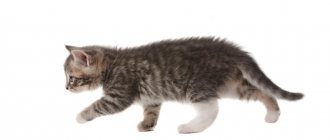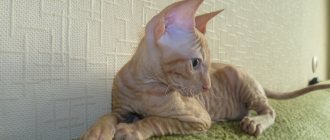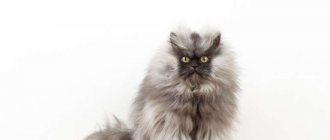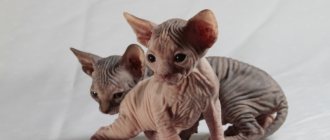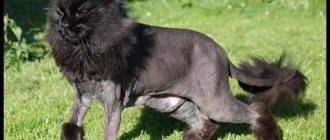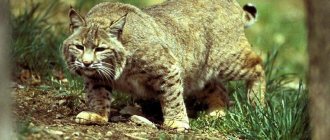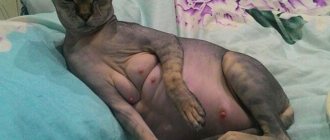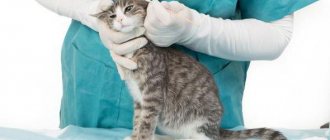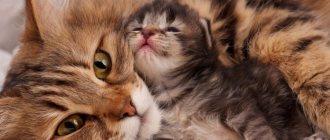Save article:
Before purchasing a long-haired cat, remember that similar breeds, such as Persian and Angora, require constant care. The length of the coat of these breeds sometimes exceeds 10 cm, and with infrequent brushing, tangles form. So make sure you have time in your schedule to set aside about 30 minutes a couple of times a week to groom your cat.
.
global $ads_google; //data-ad-slot=”2475549904″ $ads_google = empty($ads_google) ? false : true; ?> if ($ads_google == false) {?>
$ads_google = true; ?> } ?>
For care you will need special equipment: a brush with natural bristles; combs with teeth of various frequencies and blunt ends, scissors with rounded edges, used for cutting out matted wool. Antistatic spray and powder are also used to facilitate care procedures.
When combing the fur on the face and paws, a slicker brush is used; its use is not recommended for other parts of the body, as there is a risk of damage to the structure of the undercoat, which can be slowly restored. Combs with teeth of varying densities and blunt ends will come to the rescue here. When combing out tangles, combs with teeth of various lengths are used. It is not recommended to use plastic equipment, as wool becomes electrified when interacting with it.
It is recommended to adhere to the following combing order: start with the head and neck, move to the back and sides, then the chest, belly, paws (start with the hind legs, pay attention to the armpit area). It is necessary to finish combing on the tail, which requires minimal impact. First, combing is done with a soft brush against the hair, then along the hair. If the fur is initially very tangled, then first use a sparse comb, and only after that take up the brush. An antistatic spray can be applied to combed fur, but the product cannot be used during the first year of the animal’s life. Additionally, you can apply talc to the wool, which will help it become less tangled, and for additional shine, you can use a solution of citric acid.
Caring for Persian cats
The hair of Persian cats is long, light and fluffy. With poor care, it quickly gets tangled and rolls down to such an extent that sometimes the only way to cope is to cut off the problem area. Particular attention should be paid to grooming during shedding, otherwise the cat may experience digestive problems due to ingestion of hairballs. And the owners will have to collect wool from the floor and interior items.
To preserve the rich color of wool, talc, starch or powder are used. To make it even more decorative, you can trim off the excess hair on the cat’s ears. The condition of the coat can be further improved by trimming hairs that stand out in length or color.
Eye hygiene in furry cats
The fur on the face is the place where the cat takes care of the hygiene of dead hairs 100%, but she can no longer clean her eyes. In this case, it is doubly difficult for long-haired cats - the hairs constantly loom near the eyeball and either stick to it, or carry dust, or even provoke the development of conjunctivitis or some more serious disease of the eye or eyelids.
In this regard, the owner of a fluffy cat is required to carry out a daily ritual of cleaning the cat’s eyes using a cotton pad and a chamomile solution or a special solution from a veterinarian. Of course, the cat won’t come into the bathroom every hour and remind you that it’s time to wash your face. Therefore, just make it a rule: if you wash yourself, wash the cat.
Another advantage of the procedure is that you will be able to notice any signs of developing eye disease in the early stages and promptly contact a veterinarian for help in treatment.
When to start caring for your cat's fur?
It is better to start grooming from an early age, which will help the animal become better accustomed to hygiene procedures. The procedure should be performed carefully, without causing pain. If the cat is long-haired, pay special attention to the chin area, behind the ears and in the lower part of the body.
Lumps should be combed out especially carefully; special tools or improvised means are used for this purpose, for example, knitting needles. It is necessary to comb with smooth movements, otherwise the animal will resist the procedure. You need to be especially careful when brushing the belly, as this is where the animal feels the most pain.
History of the breed, origin
Despite the fact that the Kuril Bobtail was identified as a breed only in 1991, its ancestors, which also had a short tail, have been found on the Kuril Islands since at least the 18th century. Felinologists suggest that this breed was formed in natural conditions naturally due to the mixing of Japanese Bobtails and Siberian cats. The former lived on the archipelago since ancient times, but the Siberians were brought to the Kuril Islands by sailors.
This is interesting! Before the advent of the Russian breed, American breeders for several decades tried to breed cats with the characteristics that nature endowed Bobtails with.
The islands of Iturup and Kunashir are recognized as the homeland of the Kuril Bobtail, from where they began their journey at the end of the 20th century, first across mainland Russia, and later to other countries. Already the first matings showed that a special tail is passed on from parents to offspring and does not have a negative effect on the health of cats. Since the property of Bobtails that was of interest to felinologists turned out to be heritable, the first standard for this breed was adopted on October 21, 1991.
It was further refined and improved as the Kuril breeding developed. In 1994, a seminar was held at which Russian felinologists put forward their proposals for improving the breed standard, the goal of which was international recognition of the Kuril Bobtail.
In Europe, interest in new short-tailed cats flared up in 1995, and at the same time they received official registration and recognition. By this time, nurseries had already been created that specialized in breeding both categories of Bobtails - longhaired (divided into two varieties - longhaired and semi-longhaired) and shorthaired.
Serious look
In 2001, the Felinological Association of CIS clubs clarified the breed standards, which confirmed their immutability.
This stability of the new breed became the impetus for the official registration of Kurilians by the felinological association FIFe, which took place in 2004.
The Kurilian Bobtail was registered in the American Associations of Felinologists in 2012.
Today the breed continues to gain popularity in different countries. These cats are prized for their pleasant, good-natured nature, hunting instincts and unusual appearance with a pom-pom tail. However, they are still not as numerous as the old breeds, whose history goes back many decades.
Bathing cats
global $ads_google; //data-ad-slot=”2475549904″ $ads_google = empty($ads_google) ? false : true; ?> if ($ads_google == false) {?>
$ads_google = true; ?> } ?>
The pet is usually bathed once every six months, most often only the hairless ones, since they sweat intensely, and the rest - as needed. In addition, cats usually do not like to bathe, so this procedure will only cause additional stress.
Some breeders advise bathing cats once a month with special products that do not harm the fat layer. This frequency is usually recommended for bathing kittens and adult pets.
To bathe, it is necessary to create certain conditions; this process must take place in a warm room without drafts. The ears are covered with cotton swabs to prevent water from entering. Use water with a temperature of 38-39°C. There are special shampoos for kittens, for the fur of cats of different lengths and colors, and medicinal products. High-quality products are made from herbal ingredients; they are more expensive, but it is better to purchase a good product than to cause irritation to the skin. After using shampoo, rinse your cat thoroughly with water. Use a terry towel to dry the wool.
If the coat is contaminated with dye or resin, you should clean it with vegetable oil before bathing. If the wool is very dirty with such products, you can use alcohol, but do not allow contact with the skin. You should not let your pet go outside immediately after bathing to avoid catching a cold.
It is worth remembering that you should not bathe your animal for two weeks after vaccination!
Combing
Many long-haired cats require daily brushing, otherwise their fur will quickly become matted.
To groom your long-haired cat, you will need three types of brushes: a soft brush, a metal round-tooth comb, and a slicker brush. Sometimes a tangle cutter may be required.
Double sided brush
It is better to brush your cat daily - in this case, grooming will only take you a few minutes.
Gently run the brush over the back, belly, tail, chin and paws. A comb with metal teeth is needed to comb out small tangles.
Metal comb
Once you have identified the mat, gently pinch the fur with your fingers near the skin and begin to slowly comb out the mat. If you have missed a few days, the tangle may be large - then you will need a tangle cutter.
Colt cutter
It will cut the hairball into several small ones that you can either pull out with your fingers or comb out with a round-tooth comb.
After brushing, run a slicker through the coat to remove any fine fluff and smooth the coat.
Slicker brush
However, the choice of the site sympaty.net is a furminator.
This is a universal device that replaces most brushes. It does an excellent job of removing loose hair and undercoat, combs well and does not cause discomfort to the cat. It is the one that best helps get rid of hair flying in the air, reduces the appearance of shedding and perfectly prevents the formation of trichobezoars in a cat.
Furminator brush
Trichobezoars
Trichobezoars are hairballs that form in the gastrointestinal tract. They occur more frequently in long-haired cats than in short-haired cats and can cause vomiting or coughing, and in severe cases, intestinal obstruction.
Proper care for a long-haired cat must include the prevention of the appearance of trichobezoars. To do this, pets are given pads or paste to dissolve the hair or fed with special food.
Danger of tangles and wool ingestion
If a cat licks its fur, the hairs get into the digestive tract. When there is a large accumulation of them in the stomach, under the influence of enzymes, the wool forms dense lumps - bezoars, causing the risk of intestinal blockage. You can cope with them by dissolving lumps using special pastes, tablets and gels.
What is the danger of mats? The tangles pull together nearby growing villi, causing discomfort for the cat. The animal may try to get rid of the lumps itself, resulting in damage to healthy skin with its claws. The tangles adhere tightly to the skin and prevent oxygen from reaching it, which leads to diaper rash and skin diseases. If the tangle cannot be untangled, it is cut along the direction of hair growth or across it.
Nutrition for fluffy cats
No matter how you brush your fluffy cat, he will still lick himself. And ingestion of wool inevitably leads to the formation of trichobezoars in the gastrointestinal tract (accumulation of hairballs that are difficult to remove from the cat’s stomach and intestines, and in especially severe cases can lead to blockage and death from intoxication).
The problem is solved by timely and complete combing and nutrition with an enhanced fiber complex.
If you feed dry food, then choose super-premium food, which contains 80% protein, and 20% only from vegetables, herbs and fruits. There should be no mention of any rice, corn or sweet potato in the composition. Fiber is very important for removing feces and swallowed hair along with them. Also, high-quality dry food has a good composition of mineral and vitamin complex, which will have a beneficial effect on the cat’s fur.
If you feed a fluffy cat using a natural food system, then 20% of the carbohydrate part should consist of grated cucumber, carrots, pumpkin, chopped parsley, zucchini, celery. All these components can be alternated and given depending on the taste preferences of a particular fluffy.
Regardless of the type of food, grow “cat grass” for your pet, because it is often easier for a cat to regurgitate a hairball after it than to remove it through the anus with the rest of the digested food.
Otherwise, the features of keeping all types of fluffy cats do not differ from keeping other cats. Good nutrition, regular hygiene and checkups with a veterinarian, love and care are the components of a happy and healthy cat.
Haircuts for cats
People have different attitudes towards haircuts. Some consider it a fad, while others see it as an urgent need. Haircuts can be done as for participation in competitions, and then the necessary conditions are prescribed for each breed, or there can simply be free-style home hairstyles, the most popular of which are the “French Lion” and “Puss in Boots.” In both options, the muzzle, paws and tail are usually left untouched. Skilled groomers can create various patterns on the coat. In summer, a short haircut will help your pet not to overheat and not pick up dust and dirt.
How to choose a kitten
- As the breed continues to gain popularity, buyers will encounter unscrupulous sellers selling problem animals. In order to purchase a kitten, it is better to go to breed exhibitions where professionals gather.
- Fans of more playful pets are advised to opt for a male kitten. Long-haired “British girls” are calmer and more phlegmatic than males.
- Look for a nursery registered in the WCF felinological system - such institutions value their reputation and do not breed animals without pedigrees. In addition, the websites of most of them contain photos and documents of the producers, from which you can get a relative idea of the appearance of future litters.
- British Longhair kittens are sold starting from the age of three months. If the breeder offers to give the baby away earlier, there is a catch.
- In three-month-old kittens, the exterior potential is practically not visible, so for exhibitions it is better to take older individuals (4-6 months), whose iris color has been determined and the first moult has passed.
- Assess the living conditions of the cat and its offspring. The nursery should be clean and warm, and the animals should look healthy and well-groomed.
- Browse advertisements for the sale of child support children. They are given by cat owners who receive a kitten as payment for mating their ward with a cat from the nursery. Buying such kittens is quite acceptable, especially since the maintenance animal is given away first, and is usually the cutest kitten in the litter. The main thing is to check the purity of the parents’ pedigrees.
What experts say
It is very important to know that almost any manipulation can cause serious stress or an aggressive reaction on the part of the cat. Therefore, all care must be carried out carefully and quickly. It is advisable to enlist the help of another person.
Not all animal groomers are willing to work with domestic cats. The stress may be so severe that your pet will require veterinary care during procedures. There are also frequent cases of death right on the grooming table. For this reason, specialists either refuse or ask the owners to be nearby in case of an emergency. Some time before grooming, it is recommended to give the cat a sedative.
Shedding
Shedding is a natural process common to all animals.
However, owners of long-haired cats often notice that their pets' shedding seems to last all year round. This happens because the domestic cat constantly lives in a warm place, does not feel the reduction in daylight hours due to artificial lighting, and, if there is an air conditioner, does not feel the heat.
How to reduce shedding:
- brush your cat daily;
- if you feed your cat commercial food, buy food containing omega-3.6 fatty acids;
- Give your cat vitamins containing biotin regularly (2-3 times a year).
A noticeable deterioration in the quality of the coat can be associated with improper care of long hair, an inadequate diet, and various diseases (kidney failure, diabetes, hormonal disorders).
Also, heavy shedding begins when the cat is stressed.
If shedding does not stop for a long time, or the fur has become dull and disheveled, take your cat to the veterinarian.
Caring for a long-haired cat is not at all difficult if the cat is healthy, eats properly and is not overweight. Most cats love being brushed and will happily expose their backs and bellies to the brush.
And you only need a few minutes a day to care for your pet’s fur.
Why is it required?
Cats are quite independent and are quite capable of taking care of themselves on their own. However, their coat undergoes seasonal shedding 2 times a year and during this period the wool literally scatters around the house. This does not mean that the rest of the time the pet does not need combing. At least once a week, the owner should scratch his cat's coat, especially if it belongs to long-haired breeds. It is recommended to arrange a “bath” for your ward 1-2 times a year. Exotic lovers even turn to hairdressers to give them a fashionable haircut.
